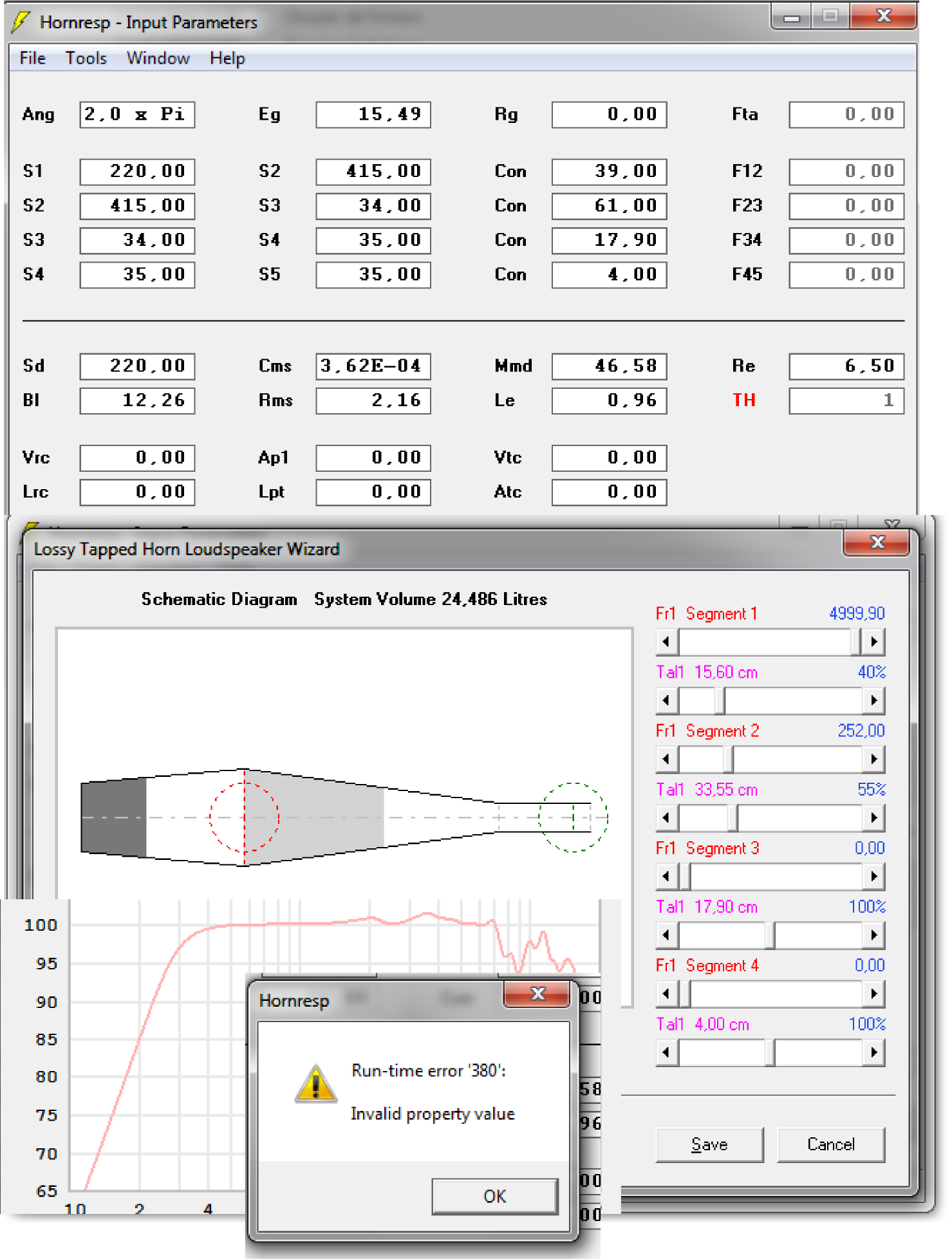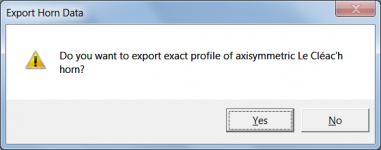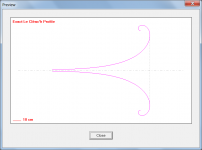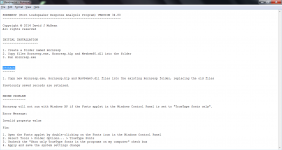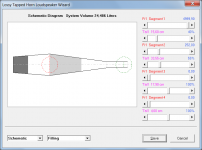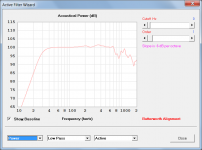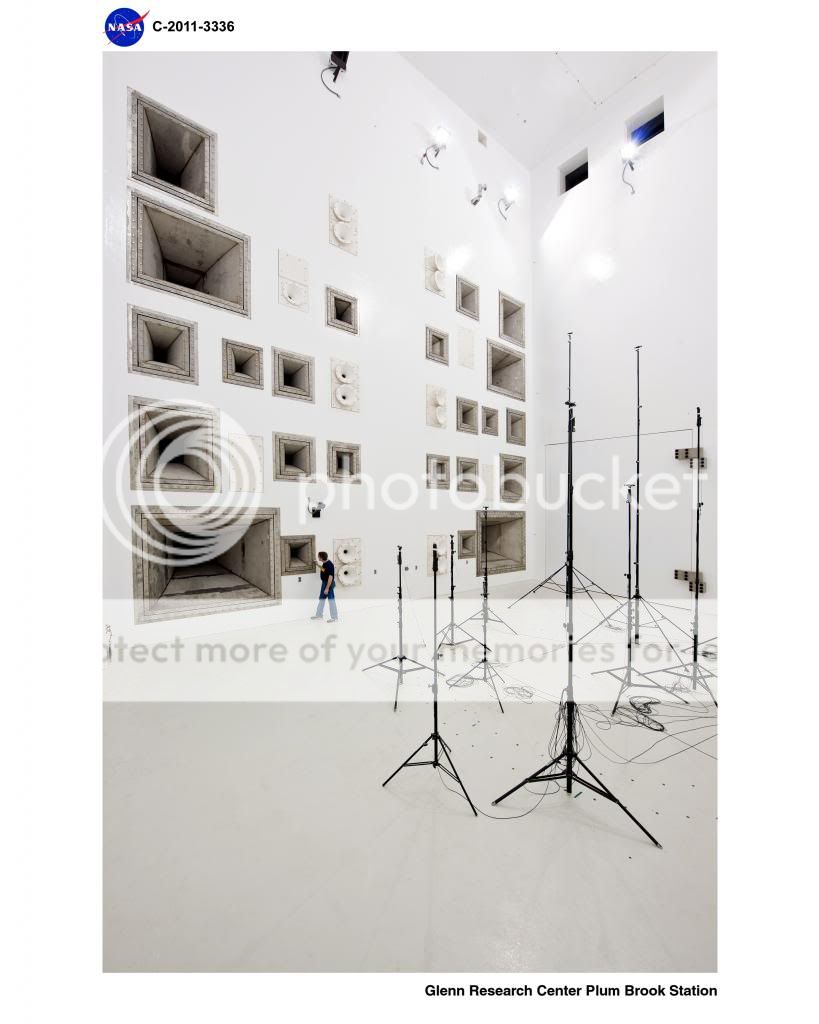Hornresp Update 3480-140612
Hi Everyone,
CHANGE
Unfortunately a fatal bug was introduced in the recent Version 34.80 release. It prevented the calculation of results for some Le Cléac’h horn designs. The program would lock up due to an infinite loop. The problem has now been fixed.
My apologies for any inconvenience caused.
Kind regards,
David
Hi Everyone,
CHANGE
Unfortunately a fatal bug was introduced in the recent Version 34.80 release. It prevented the calculation of results for some Le Cléac’h horn designs. The program would lock up due to an infinite loop. The problem has now been fixed.
My apologies for any inconvenience caused.
Kind regards,
David
So this is a great time to have found it!
Hi Mark,
It certainly is
The bug was a particularly nasty one - it caused Hornresp to "seize up" completely.
The only way out was to open the Windows Task Manager and force the program to close.
Kind regards,
David
Hi !
As it seems your looking at correcting error, i just got one !
It has been some time that i didn't played with hornresp (relatively...), around 3 month. Updated the version, and i now get a error with a stupid TH design when trying to go to filter design from loudspeaker wizard, whereas the tool still work with other designs... I wanted to play with high pass filter vs excursion & power ...
Here is the design :
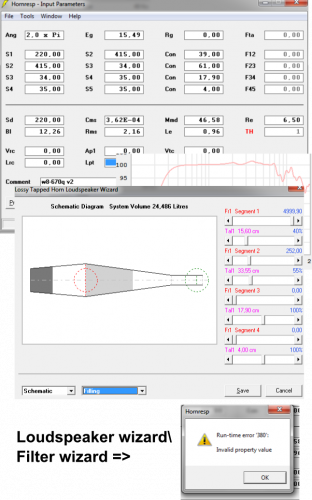

Damien
As it seems your looking at correcting error, i just got one !
It has been some time that i didn't played with hornresp (relatively...), around 3 month. Updated the version, and i now get a error with a stupid TH design when trying to go to filter design from loudspeaker wizard, whereas the tool still work with other designs... I wanted to play with high pass filter vs excursion & power ...
Here is the design :

Damien
Last edited:
Hornresp Update 3480-140617
Hi Everyone,
CHANGE 1
A preview axisymmetric schematic diagram is now displayed before the exact Le Cléac’h profile horn data is exported.
CHANGE 2
Instructions have been added to the Readme.txt file detailing the Hornresp upgrade procedure. This change was prompted by users reporting that they could no longer access their existing saved data after updating to a later release. This occurred because they had installed the new version of Hornresp in a different folder to the old version.
Kind regards,
David
Hi Everyone,
CHANGE 1
A preview axisymmetric schematic diagram is now displayed before the exact Le Cléac’h profile horn data is exported.
CHANGE 2
Instructions have been added to the Readme.txt file detailing the Hornresp upgrade procedure. This change was prompted by users reporting that they could no longer access their existing saved data after updating to a later release. This occurred because they had installed the new version of Hornresp in a different folder to the old version.
Kind regards,
David
Attachments
It has been some time that i didn't played with hornresp (relatively...), around 3 month. Updated the version, and i now get a error with a stupid TH design when trying to go to filter design from loudspeaker wizard, whereas the tool still work with other designs... I wanted to play with high pass filter vs excursion & power ...
Hi Damien,
Many thanks for the feedback.
Unfortunately for some strange reason I cannot generate the error message you are seeing. For me, the Filter Wizard opens just fine from the Loudspeaker Wizard when I use your input data.
I would be interested to know if anyone else has the same problem as Damien when they use the design data as given in his second Post #4566 (click on embedded image to enlarge).
Kind regards,
David
Attachments
Hi David !
It seems to be related to the record itself ! When i add a record, from this record, the bug is still there.
But i have tryed to do something else : if i make a new record from another design, and change everything to do "stupid design", the bug is not there anymore ! ^^
Damien
It seems to be related to the record itself ! When i add a record, from this record, the bug is still there.
But i have tryed to do something else : if i make a new record from another design, and change everything to do "stupid design", the bug is not there anymore ! ^^
Damien
post4568
that is the widest frequency range I have seen from a Tapped Horn.
Not just a couple of octaves, but 4.5 octaves (~30Hz to ~700Hz)
That is because it is not a tapped horn.
The only way to increase efficiency is to decrease the usable bandwidth. The more optimised a enclosure is from the efficiency standpoint the smaller the usable bandwidth.
Many people are creating designs that have the elements of a tapped horn without the efficiency gains associated with an optimised design.
This is a perfect example of a a very wide bandwidth vented enclosure.
A true taped horn optimised for at least 7 db gain over an equivalent sized conventional vented box will have a wavy output. Plus or minus 3db at least. And the electrical impedance will show the points where the maximum efficiency has been gained. There should be three of them.
A properly designed tapped horn is a sports car. There are serious trade offs between a sports car versus a sedan. Many bumps on the road.
Not a nice flat line.
From what i understand, it's in the family of tapped horn. Dimensions are just tuned, as any other kind of design can be tuned. But in fact, Bjorno would probably call this a ST-TQWT (S for strangled ^^)...Because of the high compression ratio, it probably won't work as well as it sims. Not only response is flat, but it's only 24 liters with a cheap w8-670q. The idea is to have two of this below sofa to get not so bad headroom for a little room.
It seems to be related to the record itself ! When i add a record, from this record, the bug is still there.
But i have tryed to do something else : if i make a new record from another design, and change everything to do "stupid design", the bug is not there anymore ! ^^
Hi Damien,
This is very interesting.
Could you please select the menu commands File > Export > Hornresp Record from the Input Parameters window, save the faulty TH record to a *.txt file, and then include the file as an attachment to a Post (the location of the exported record file is shown at the bottom of the 'Export Hornresp Record' form).
To attach the file to your Post, first click on the 'Manage Attachments' button in the 'Additional Options' section below the message input window, then find the exported record file using the top 'Browse' button and finally, attach it to your Post using the 'Upload' button. Close the window by clicking on the 'Close this window' button at the bottom of the form.
I can then have a look at your record to see if I can work out what is causing the problem.
For your information, I have attached a copy of the export file for my record, which seems to work okay.
Thanks and kind regards,
David
Attachments
From what i understand, it's in the family of tapped horn. Dimensions are just tuned, as any other kind of design can be tuned. But in fact, Bjorno would probably call this a ST-TQWT (S for strangled ^^)...Because of the high compression ratio, it probably won't work as well as it sims. Not only response is flat, but it's only 24 liters with a cheap w8-670q. The idea is to have two of this below sofa to get not so bad headroom for a little room.
Hi Damien,
The efficiency is low for a tapped horn, at around 0.28% at 100Hz. SPL is approx 86dB for 2.83 volts input.
Kind regards,
David
yes...but it s just a cheap w8-670q in few liters that should be easy to cross to take no more than 30w.Hi Damien,
The efficiency is low for a tapped horn, at around 0.28% at 100Hz. SPL is approx 86dB for 2.83 volts input.
Kind regards,
David
For home use power (and so efficiency) is not a problem with a multi-sub approch.
I ll upload file when i get back home
Last edited:
Re. post #4574:
Maybe not Hi-Fi, but looks like "stereo" for the most part. What do you suppose they play there, and for what purpose?
I think they playback the sound of a launch vehicle in an effort to validate payload items as fit for launch.
That is because it is not a tapped horn.
You might remember that you, me and Bill Fitz discussed these issues in the past. And I still disagree with you guys. If you recall, you guys insisted that a horn needed a certain amount of efficiency to be called a horn. But tapped horns are not horns, in fact the vast majority of front loaded horns are not horns either, depending on your definition of horn. A "true" horn will have a mouth circumference equal to it's tuning wavelength. And there is NO accepted definition of horn that I know of that includes a certain amount of efficiency to qualify as a horn. This thing might be less hornlike than your average tapped horn, but no tapped horn is a "true" horn anyway. So semantics don't really matter.
The only way to increase efficiency is to decrease the usable bandwidth. The more optimised a enclosure is from the efficiency standpoint the smaller the usable bandwidth.
Not true, or misleading at best. As I stated in the past, efficiency is all about size. I can show you 30 db of gain over at least 3 octaves from almost any driver if there's no size limit imposed (in a front loaded horn). And bandwidth is all about how many impedance peaks you have and how you space them out.
Many people are creating designs that have the elements of a tapped horn without the efficiency gains associated with an optimised design.
"Optimized" has no meaning without a definition of the desired characteristics and design goals. If small size is a goal (and it most often is), then a design is most certainly optimized even if it doesn't have high efficiency.
A true taped horn optimised for at least 7 db gain over an equivalent sized conventional vented box will have a wavy output. Plus or minus 3db at least. And the electrical impedance will show the points where the maximum efficiency has been gained. There should be three of them.
A properly designed tapped horn is a sports car. There are serious trade offs between a sports car versus a sedan. Many bumps on the road.
Not a nice flat line.
Again not true. Here's a high efficiency, wide bandwidth tapped horn with a whole lot more than 7db of gain. It's +/- less than 2 db, no big bumps on this road. It's about 8x larger than the average design for this driver. For a given tuning efficiency is based on size, not good design or some type of magic. And there's no definition that states a tapped horn has to have a wildly peaky response.
An externally hosted image should be here but it was not working when we last tested it.
Getting all caught up in definitions and semantics is a huge problem. It forces certain ideas that cause you to miss the forest for the trees.
Last edited:
- Home
- Loudspeakers
- Subwoofers
- Hornresp
